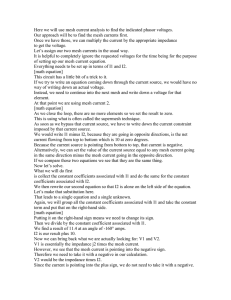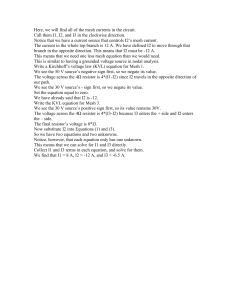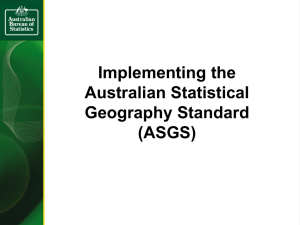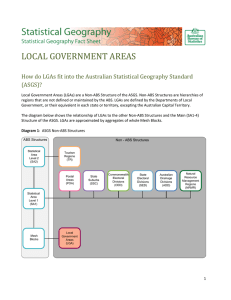MESH BLOCKS What are Mesh Blocks?
advertisement
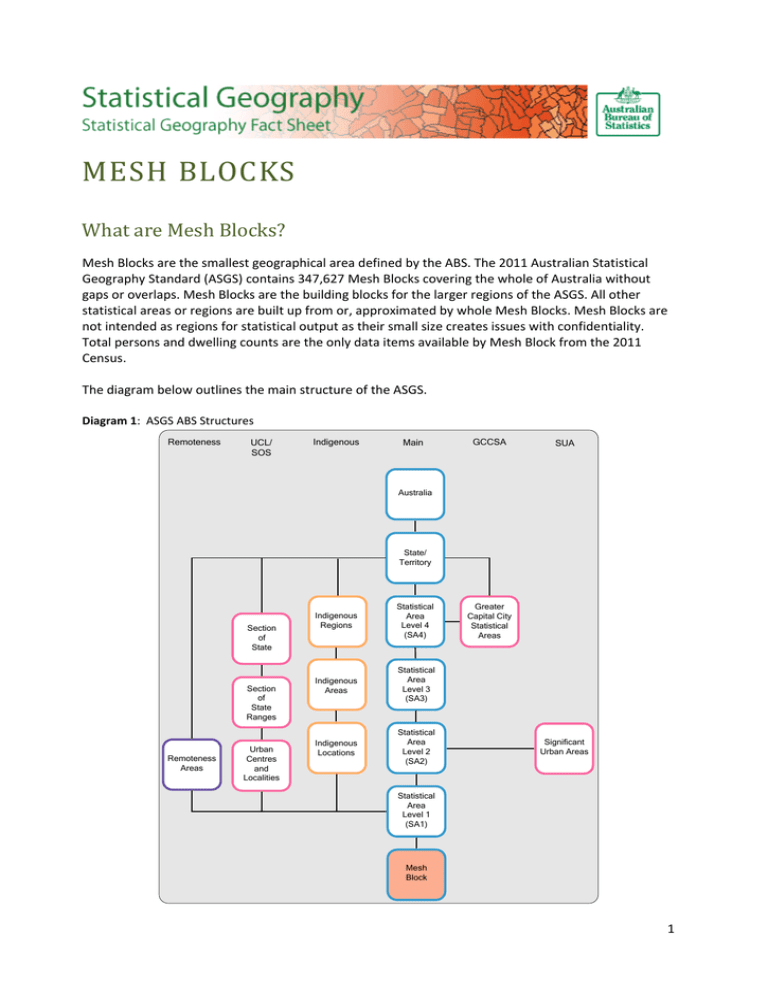
MESH BLOCKS What are Mesh Blocks? Mesh Blocks are the smallest geographical area defined by the ABS. The 2011 Australian Statistical Geography Standard (ASGS) contains 347,627 Mesh Blocks covering the whole of Australia without gaps or overlaps. Mesh Blocks are the building blocks for the larger regions of the ASGS. All other statistical areas or regions are built up from or, approximated by whole Mesh Blocks. Mesh Blocks are not intended as regions for statistical output as their small size creates issues with confidentiality. Total persons and dwelling counts are the only data items available by Mesh Block from the 2011 Census. The diagram below outlines the main structure of the ASGS. Diagram 1: ASGS ABS Structures Remoteness UCL/ SOS Indigenous Main GCCSA SUA Australia State/ Territory Section of State Section of State Ranges Remoteness Areas Urban Centres and Localities Indigenous Regions Statistical Area Level 4 (SA4) Indigenous Areas Statistical Area Level 3 (SA3) Indigenous Locations Statistical Area Level 2 (SA2) Greater Capital City Statistical Areas Significant Urban Areas Statistical Area Level 1 (SA1) Mesh Block 1 Diagram 2: ASGS Non-ABS Structures ABS Structures Statistical Area Level 2 (SA2) Non - ABS Structures Tourism Regions (TR) Postal Areas (POA) State Suburbs (SSC) Commonwealth Electoral Divisions (CED) State Electoral Divisions (SED) Australian Drainage Divisions (ADD) Natural Resource Management Regions (NRMR) Statistical Area Level 1 (SA1) Mesh Blocks Local Government Areas (LGA) What criteria were used to define Mesh Blocks? The Mesh Blocks were designed using a standard set of criteria. In priority order these can be summarised as: alignment to Statistical Local Area (SLA) and consequently Local Government Area (LGA) boundaries where possible to have a dwelling count of between 30 and 60 or contain no dwellings at all be of either urban or rural character where practical, not to cross cadastral boundaries to align to gazetted suburb and locality boundaries to reflect topographic features such as rivers, road, rail, major mountain ranges and escarpments to be of a compact size and shape to broadly reflect land use – the land use categories to which a mesh block can be assigned include o water o parkland o residential o industrial o commercial o education o hospital/medical o agricultural o transport o other. 2 What data is available at the Mesh Block level? Datasets containing counts of the total usual resident population and total dwellings from the 2011 Census of Population and Housing for Mesh Blocks are available through the online publication Census of Population and Housing: Mesh Block Counts, 2011 (cat. no. 2074.0). The release of data is limited to avoid compromising the confidentiality of respondents in small geographical areas. Where can I get the Mesh Block boundaries? The Mesh Block boundaries are available in MapInfo Interchange and ESRI Shapefile formats and can be downloaded from the ‘ABS Geography Publications’ chapter of the ABS Statistical Geography website: http://www.abs.gov.au/geography Alternatively, Mesh Block digital boundaries are available through the ‘Downloads’ tab of the ASGS Main Structures online publication: Australian Statistical Geography Standard (ASGS): Volume 1 - Main Structure and Greater Capital City Statistical Areas, July 2011 (cat. no. 1270.0.55.001). Where can I get further information? A detailed discussion of Mesh Blocks and the criteria used in their design can be found in the online publication: Australian Statistical Geography Standard (ASGS): Volume 1 - Main Structure and Greater Capital City Statistical Areas, July 2011 (cat. no. 1270.0.55.001). More information on the ASGS and ABS Statistical Geography can be found by visiting the ABS website: http://www.abs.gov.au/geography Any questions or comments can be emailed to geography@abs.gov.au 3






